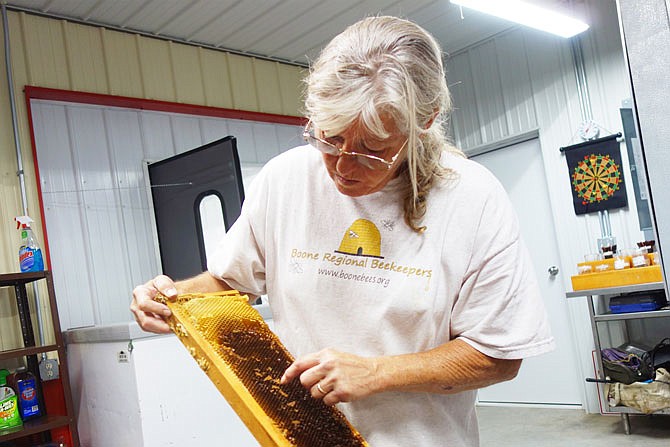MILLERSBURG - The bees miss the spring flowers.
That's why there were few buzzing around at Giofre Apiaries on Thursday, even though co-owner Nancy Giofre has nearly 100 hives.
"The honey flow this year came fast and went fast," she told a visiting group from the Fulton Garden Club. "Now we're in drought, so it's really hard on the bees. I've stopped pulling honey until I see what the fall looks like."
Nevertheless, business is booming for the Millersburg-based honey and ice cream company. Giofre Apiaries distributes its ice cream - eight ounces of which contains two tablespoons of honey - to more than 40 locations, including one in Illinois. Currently, Nancy and her husband, Domenic, produce 200 gallons per week, she said.
Giofre hopes to one day use exclusively Giofre-produced honey in the ice cream, but between a dry summer and a devastating plague of Japanese beetles, that isn't quite practical yet. Purchasing honey from a beekeeper in nearby Fayette has helped make up for the honey shortfall.
Despite the difficulties, she managed to produce 3,000 pounds of honey in 2017, and has harvested 2,000 pounds so far this year. She's even hired an apprentice. Not bad for a person who started as a novice apiarist (also known as a bee keeper) in 2009. She began with just two hives, purchased from a beekeeping friend.
"I've learned a lot," she said. "If there's a mistake to be made, I've made it and learned from it."
By 2014, she and Domenic were producing honey ice cream for the Missouri State Beekeepers Association's booth at the state fair.
One of her tricks is spreading the hives around to different properties. Bees need at least half an acre per hive.
"I'm always looking for new places to put a hive," Giofre said.
She's also constantly on the lookout for threats like hive beetles, which move into a hive, eat honey and reproduce until bees flee.
Another important part of beekeeping: getting to know your bees.
"When I think of a hive, I think of it not as 60,000 bees but as a unit," she said. "Each hive has a personality."
Some are more aggressive and some more docile, for example.
She must also manage the amount of honey in each hive - removing enough to keep the bees healthy but still leaving enough for winter. Then there's the labor of readying the honey for bottling or use in ice cream and other products.
The hard work is worth it, according to Fulton Garden Club members who sampled ice cream and honey Thursday, including warm, lavender-infused honey straight from the vat.
The club also appreciated the tips Giofre shared about how to grow lavender, which apparently appreciates lime and sand in its soil.
"You're teaching the garden club about gardening," club President Diane Neterer said with a laugh.
As a thank you for hosting the group, she and club member Becky Guerrant brought some live coreopsis, rudbeckia and purple coneflower plants.
Those thirsty bees will certainly appreciate it.
To learn more, visit thehoneyicecreampeople.com.

